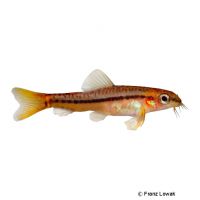Rosy Loach (Petruichthys sp. 'Rosy')
| Rosy Loach Petruichthys sp. 'Rosy' | |
|---|---|
| Name | Rosy Loach |
| Name Lat. | Petruichthys sp. 'Rosy' |
| Synonym | Yunnanilus sp. 'Rosy' |
| Family | Stone Loaches |
| Family lat. | Nemacheilidae |
| Order | Carps |
| Order lat. | Cypriniformes |
| Origin | Myanmar |
| Habitat | Ponds |
| Diet | Omnivore |
| pH | 6.5-8.0 |
| Behavior | Peaceful |
| Keeping | Group |
| Care Level | Moderate |
| Reproduction | Egg scatterer |
| Breeding | Difficult |
| Life Span | 3-5 years |
| Protection | No |
| Metric Units | |
| Size | 3 cm |
| Temperature | 20-26 °C |
| Hardness | 5-15 °dH |
| Aquarium | ~ 80 l |
| US Units | |
| Size | 1.2" |
| Temperature | 68-79 °F |
| Hardness | 89-267 ppm |
| Aquarium | ~ 20 gal |
Distribution and habitat
The range of the Rosy Dwarf Loach is waters in eastern Myanmar. They are schooling fish that live in the shallow waters of flooded grasslands and in ponds with soft, sandy bottoms and dense vegetation.
Maintenance
The aquarium should have dense planting with hiding places (roots, caves) and provide sufficient swimming space. In order not to injure their barbels, they need a soft, sandy substrate, which can be covered with some foliage (e.g. sea almond leaves). Some shaded light (floating plants) and medium hard water is ideal
No ammonia, ammonium and nitrite should be detectable, the nitrate value should not exceed 100 mg/l. To ensure the water quality and oxygen content, a filter and heater adapted to the aquarium size is required, as well as lighting for the species-appropriate day-night rhythm of the animals.
Diet
They feed mainly on insects, small crustaceans and microplankton. The food supply consists of live, frozen and dry food. For a balanced diet, feed once daily with a high quality sinking dry food (granules, pellets, food tablets) as well as cyclops, daphnia, artemia, mosquito larvae and plankton (live or frozen). In addition, they also need some vegetable food, such as algae leaves or dry food with high vegetable content (e.g. kelp, spirulina).
Only feed as much as will be eaten within a few minutes. A regular and varied diet promotes health and increases resistance.
Behaviour and compatibility
These peaceful and swimming swarm fish should be kept in a group of at least 8-10 animals. A socialization with other peaceful fish, such as small danios (Rasboras, Boraras, Danios etc.) and catfish is well possible.
Basically, only compatible fish species with similar demands on water condition and water temperature may be socialized.
Sex dimorphism
The females and males are colored differently (sexual dichromatism). The somewhat larger and rounder appearing females are light beige, while the slimmer males are intensely orange in color.
Reproduction and breeding
The breeding in the aquarium has already succeeded several times. They are free spawners and do not practice brood care. After about 24 hours the larvae hatch and after another 24-36 hours the fry swim free.
The fry must be fed several times a day with special rearing food (dust food, microworms, Artemia nauplii). In community tanks breeding is hardly possible, because the fry are easy prey.
Important
They are not bottom-oriented like most loaches, but are free-swimming schooling fish.
The foliage (sea almond tree, oak, etc.) when rotting promotes the development of microorganisms, which are a valuable secondary food source.
The well-being of the fish should be monitored regularly. Temperature should be checked daily, pH, hardness and nitrate levels should be checked at least every 14 days. Regular partial water changes are recommended, even when contaminant levels have not yet reached the upper limit. Sudden changes in water quality should be avoided. Newly introduced fish must be accustomed slowly to the water in the aquarium.
Further literature can be found in your pet store.
References
Text: petdata; Image: Franz Lowak
Source: BMELV (1998): Tierschutzgutachten - Haltung von Zierfischen (Süßwasser); ENGELMANN (2005): Zootierhaltung - Tiere in menschlicher Obhut: Fische, Verlag Harri Deutsch
- Gemäß § 21 Abs. 5 Tierschutzgesetz idgF
